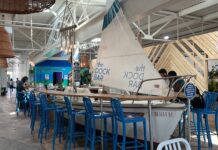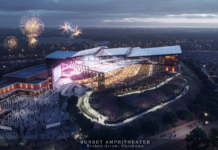With more than $350 million in recently completed, under construction or planned projects happening in downtown Tulsa, the hullaballoo inside the inter-dispersal loop is enough to make one’s head spin. While the rebirth of downtown appears to be enjoying an overnight success, those closely involved know it has been a long process that has been almost 20 years in the making. Thanks to several dedicated leaders and visionaries, downtown Tulsa is coming back to life.
Once dubbed “The Oil Capital of the World,” early Tulsa enjoyed being in the nation’s spotlight as one of the most progressive and cosmopolitan cities of its time.
Over the years, because of trends such as urban sprawl and a recessed economy, downtown Tulsa saw a steady decline as it slowly became a ghost of its former self.
Instead of watching downtown’s slow death, several leaders decided something needed to be done.
“A healthy downtown is vital to a city and its surrounding suburbs,” says Delise Tomlinson, executive director of downtown development at the Tulsa Metro Chamber. “Thanks to the city leadership in the late ‘90s and early 2000s, Vision 2025 was set in place.”
According to Tomlinson, Vision 2025, along with visionaries from the private sector such as Tom Wallace, Elliot Nelson, Michael Sager, David Sharp and countless others, were the impetus behind downtown’s revitalization.
“We are now reaping the benefits of the hard work that was put in place so many years ago,” Tomlinson says. “We as a community should be patting ourselves on the back.”
What is the secret to a successful revitalization? According to Elliot Nelson, owner of The McNellie’s Group, whose successful restaurants and other venues have changed the landscape of the Blue Dome District, it’s a combination of public and private partnership.
“Revitalization cannot solely be dependent on private dollars,” Nelson says. “It has to be a partnership between the city and the private sector. We have come a long way, but we still have a ways to go to ensure continued growth.”
Perhaps a sign of the renewed energy of downtown is the vibrancy of the landmark Summit Club. Although an iconic presence since it opened in 1967, a recent renovation has renewed the hip, modern sophistication of the club – and, as always, members of the private club enjoy the most spectacular views of downtown Tulsa, in addition to elegant and cordial benefits. As goes downtown, so goes the Summit Club, and today the only city club in Tulsa is enjoying its healthiest membership in its lofty history.
“We continue to implement our long-term strategy and are looking forward to unveiling our renovation plans for the 30th floor ballroom,” says Summit Club President Frazier Henke. “Our goal has been to have the premier city club in the region, and we are excited to be participating in the resurgence of downtown Tulsa.”
Housing remains a critical component of downtown’s vitality. There is a huge demand for affordable housing.
“I have over 500 employees who mostly work downtown,” says Nelson. “But none of them can afford to live here.”
The good news is that downtown housing market is at 100 percent occupancy rate, according to Tomlinson.
“However, we need at least twice as many housing units to support the growing demand – which with all the new housing projects in the pipeline, we are well on our way to meeting this goal,” says Tomlinson.
Steve Ganzkow, a partner with American Residential Group, knows a little something about downtown housing. As developers of Tribune Lofts, Renaissance Uptown and Metro at Brady, ARG has stamped its presence on the downtown residential real estate market since the very first signs of rebirth in the area manifested.
“The good news is that all of the properties built (utilizing various incentives) – including ours – are successful and well ahead of projections,” says Ganzkow.
While Ganzkow says that the profile of downtown residents is quite diverse, the price points for downtown housing is less so.
“We’re looking at another project with some partners right now that’s not ready to announce,” he says. “We’d like to do at least another 100 units in downtown. We want to focus on affordability to make it available to a broad spectrum of people. We’re sharpening our pencils and working the numbers to see how we can make it happen.”
That, Ganzkow says, is an important factor in what the next phase of downtown’s evolution will look like. He also notes that the downtown residential market is inexorably linked to the job market downtown. If the commercial real estate market can adequately represent that job market, then the news is upbeat.
“The commercial real estate market in downtown Tulsa is definitely picking up, as we are seeing companies starting to relocate from the suburbs into downtown. This is an exciting shift for downtown,” says Lisa Brandes, vice president of Kanbar Properties. Kanbar owns 2.2 million square feet of commercial real estate in the central business district of downtown Tulsa. This square footage is spread among 14 office buildings, most of which are Art Deco from the ‘20s and ‘30s.
Brandes says that the energy downtown is different from other areas of the city, and as an important contributor to the area, Kanbar is embracing its role. “We have started to utilize several of our spaces for event venues. The 41st floor at First Place Tower and the 14th floor of the Philcade building (the former apartment of Waite Phillips) are excellent new locations to hold events. The 41st floor has more of a retro feel, and the views are spectacular. We could have two or three good-sized events on this floor at one time. The Waite Phillips apartment still has many of the original features, such as the outdoor terraces, the old kitchen, restrooms and former bedrooms. It is a unique place for events and can hold around 100 people.”
Brandes adds that the company has several smaller properties well-suited for conversion to residential living or boutique hotel use, and that several parties that are interested in the buildings for such use.
“In addition to the retail, event spaces and possible conversion of some of the office properties into residential or hotel space, we are also starting to provide executive suite space in a couple of our buildings for small start-up companies,” Brandes continues. “We can put these incubator companies in small spaces on a month-to-month basis with a menu of services they choose from for their needs. This will allow those businesses to get started with a low amount of overhead; once they stabilize, the companies will have the option to move into some of our larger spaces.”
Certainly, progress in downtown has not happened in a vacuum. With the building of the iconic BOK Center, now one of the most successful concert venues in the country, and other public money through Vision 2025 that has helped remodel the Convention Center and several other historic venues; coupled with the George Kaiser Family Foundation’s grand plan for the Brady District and several entrepreneurs who have invested time, money and vision into retail, hotels, restaurants and entertainment venues – downtown Tulsa is finally becoming a place where people want to live, work and play.
Downtown’s distinctive districts are all showing signs of life, with yet more on the near horizon.
Blue Dome
Arguably downtown’s fastest growing district, thanks to entrepreneurs such as Elliot Nelson, Blake Ewing, Mary Beth Babcock and many more. Over the past five years, the Blue Dome has seen explosive and organic growth. Once a vast wasteland of empty warehouses, the Blue Dome District has come to life with retail shops, restaurants, bars and even a bowling alley.
McNellie’s, an Irish Pub opened by Nelson in 2004, was one of the first establishments to take a chance in the area.
“I love beer and I love Tulsa, and I knew (downtown) had potential,” says Nelson. “At the time I had no grand plans to open more restaurants. In fact, we weren’t sure we were even going to make it after the first 24 months.”
Thanks to his perseverance, others came to the area, such as Babcock’s Dwelling Spaces, a retail shop that focuses on locally made items, and all things Oklahoma. She is excited about the future for downtown.
“It’s gratifying to see all our hard work begin to pay off,” says Babcock. “Tulsa has such a fascinating history, and downtown has a great story to tell.”
Plans for the future include a grocery store and affordable loft living. The grocery store, called Cam’s, is tentatively set to open this year.
Deco District
This up-and-coming district is nestled in the heart of downtown amid the architecturally dazzling Art Deco buildings for which Tulsa is famous.
“We have such a beautiful downtown,” says Libby Auld, president of the newly formed Deco District. “It has been exciting to be a driving force to making this area shine again.”
Such innovations as bringing in luchadors (Mexican masked wrestling), numerous street festivals, and the recently successful Holiday Pop Up Shops have brought thousands of people to downtown.
Just recently, the Deco District has experienced a surge of growth with the addition of The Courtyard Marriott, Edward Delk’s Restaurant and Bar, Mod’s Coffee and Crepes and four new retail shops, with more on the drawing board.
More housing is also moving into the Deco District. Forty loft apartments are being built in the old Vandever Department Store and are scheduled to open in 2013. As is the case with some of their developments underway in the BOK Center area, Brickhugger envisions the Vandever project to target young people.
“We noticed when we’re leasing apartments at The Mayo, which is probably the most upscale living downtown and rich in amenities, that a lot of young people like small, one-bedroom units that are obviously cheaper,” says Macy Snyder Amatucci, vice president of Brickhugger. “We did Detroit Lofts as well, and encountered the same thing. We see a demand for that kind of housing option.”
Like other significant parties in the downtown renaissance, Amatucci notes the need for such housing options as area development proceeds.
East Village
Located just inside the inner-dispersal loop surrounding downtown Tulsa, East Village is an emerging neighborhood boasting an upscale martini bar, photography studios, lofts and the Dennis R. Neill Equality Center.
Mark Larson, a developer, recently announced the East End Village, a conversion of the former Bill White Chevrolet Dealership into loft apartments, restaurants and retail space.
Pearl District
One of Tulsa’s oldest neighborhoods, efforts have been underway to restore energy to the Pearl District as has been done in the Brady and the Blue Dome District. Anchoring the District is the hip Lot No. 6 Art Gallery and Bar, where local artists and libations are celebrated equally. Entrepreneur-turned- city councilor Blake Ewing is also planning to open the Phoenix Cafe at the corner of 6th and Peoria, among other potential new additions hoping to add luster to the Pearl.
Greenwood
Once known as the Black Wall Street, Greenwood is once again thriving thanks to the recent addition of ONEOK Field, home of the Tulsa Drillers. This state-of-the-art baseball field has spurred other development projects.
Patrick Fox, head of ZigZag Urban Development, has several projects in the pipeline for the Greenwood district. GreenArch is a 70-unit mixed-use project located at the intersection of Greenwood and Archer. GreenArch will be a new extension to the Historic Greenwood Business District, representing a renaissance of that neighborhood long in the making.
“There is no doubt that the public investment in ONEOK Field plays a huge part in the excitement over that project,” says Fox. “It includes 70 units of more affordable housing than what is currently available downtown, along with nearly 10,000 square feet of retail space.”
Fox is also working on Urban8, an eight-unit, for-sale housing project on South Greenwood and East Third Street. This development is the first of its kind downtown, representing the first new owner-occupied housing project in downtown in decades. Modern in design, these single-family homes will provide the best of both worlds: access to the burgeoning excitement of downtown while maintaining a private and convenient residence.
“The decision to invest in this project was an easy one,” Fox says. “No other part of Tulsa can claim as much public and private investment over the last two years. We are seeing many things come to fruition that have been years in the planning, and it is happening in a way that is going to insure long term growth, and a truly authentic urban lifestyle.”
BOK District
Located at the BOK Center’s front door, an exciting new development is under way. One Place is a $120 million mixed-use development which features over a million square feet of new office, retail, residential and hotel space. It will be completed in four phases, with the first phase (One Place Tower) to be completed spring 2013.
The location came from the vision of co-developers Bob Eggleston, former BOK Center Construction Executive, and Hank Pellegrini to develop around the iconic event center.
“Standing under the canopy of the BOK Center alongside world-renowned architect Cesar Pelli pointing at the downtown skyline as he exclaimed, ‘This is Tulsa!,’ I knew something significant would be built here, and I’m pleased to see that vision become a reality,” says Eggleston.
According to the Tulsa Metro Chamber, One Place will have a $150-plus million economic impact over 10 years.
Other developments in this area include a major renovation of Old City Hall into a 200-room Aloft hotel by Brickhugger, who is also responsible for the renovation of the historic Mayo Hotel. The former YMCA building at Fifth Street and Denver is also scheduled to undergo a conversion into affordable loft housing, parking and mixed-use space.
“We’re looking at about 90 units (at the YMCA site) of varying sizes beginning with small studios renting at about $500 a month,” says Hilary Hunt, vice president of Sustainable Design Build Solutions, the “boots on the ground” team of designers and builders working for Brickhugger, TOCH (with partners Neal Bhow, Lee Levinson and Bruce Taylor) on Aloft and the YMCA project. “The plan is to provide affordable starter loft housing for young people and people starting off that downtown needs. It will be something unique and cool with an industrial look.”
All of these projects are helping create density, more connectivity and more “feet on the street,” according to Tomlinson. And in the end, this translates into more jobs, more people, an increased tax base and a stronger economy.
Down In The Brady
This district is definitely creating a buzz as of late. And for good reason, as the George Kaiser Family Foundation, the City of Tulsa, several area attractions and numerous entrepreneurs are creating a dynamic, yet organic, area of downtown that will become a favorite for locals and tourists alike.
Just north of the skyline, the Brady Arts District already boasts several entertainment venues, such as the indelible Cain’s Ballroom and Brady Theater, along with several locally owned restaurants and bars. Recent and planned additions to the area include more housing, a park, streetscaping, a hotel, museum, arts center and more.
Hardesty Arts Center: Under construction on the corner of Boston and Archer, this new building for the Arts and Humanities Council of Tulsa will include exhibition spaces, studio spaces for artists, classrooms offices and a catering kitchen. It is scheduled to be completed in September 2012.
Brady District Flats: Across the street from the Hardesty Arts Center, this 40-unit housing addition will have underground parking and offer below-market rate rents for a portion of the units.
Fairfield Inn and Suites: Development partners Jeff Hartman, Greg Oliphant and David Sharp are planning to open this 104-room hotel with 11,500 square feet of ground floor retail.
“We own about three blocks, and we’re trying to create a neighborhood feeling there,” says Oliphant. “One block to the west we’re doing a historic renovation of the Ward Building. After that we’re moving up the hill to the Continental Supply building. This is an exciting time for downtown.”
Oliphant says he thinks summer 2013 will be the moment that the area reaches critical mass, with cultural components completed, enough residential development done for considerable street traffic and, of course, the new hotel open.
“With what’s happening here and in the Blue Dome, it will transform us into a destination,” Oliphant says. “That’s what it takes because there is still limited residential space downtown. We have the realization that this has to become a destination.”
Mathew’s Warehouse: An epitome of a true partnership. With help from the George Kaiser Family Foundation, this site will be the future home to Philbrook Museum’s satellite facility, the Kaiser Family Foundation, Brady Arts Alliance and the Zarrow Center for Art and Education. The Zarrow Center is set to open in May, and by June will play host to Gilcrease Museum’s summer camp for children ages 7-15. Subsequently, Gilcrease and the University of Tulsa will present programs, and there will also be exhibits of student works and adult open studio programs, according to Melani Hamilton, communications manager for the Gilcrease.
Brady Park: Currently under construction, this project, also funded by the GKFF, will include gardens, a covered pavilion, stage, canopy, fountain, trellis and café – all on top of a deep geothermal well that will heat and help cool the Tulsa Paper Co. and Hardesty Art Center.
Boulder Avenue Bridge: This City of Tulsa project is designed to accommodate pedestrians, cars, rubber-tire trolleys and fixed-rail streetcars.
Oklahoma POP Culture Museum: Paid for with state-authorized bonds and a grant from GKFF, this 67,000 square-foot museum will be dedicated to the creative spirit of Oklahoma’s people and the influence of those artists on popular culture around the world.
Tulsa Coming Attractions






















